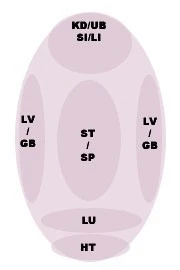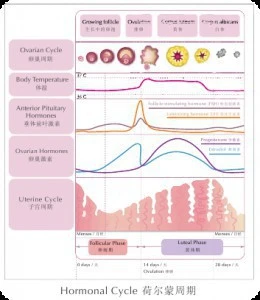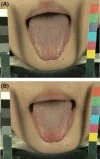Tongue Diagnosis - Study Explores Changes During Menstruation
 There are many diagnostic signs that are explored within Chinese Medicine when forming a diagnosis and treatment plan. Two of the most important are pulse diagnosis and tongue diagnosis. With tongue diagnosis we are looking at changes that your body describes by altering the body color, coating thickness and color and other aspects of the tongue. These changes guide your practitioner to better understand how well your body is functioning internally and can help clarify complicated or layered diagnoses in Chinese Medicine terms (see "What Does Acupuncture Treat?" for general information on treating the causes/roots of your issues vs. the symptoms).
There are many diagnostic signs that are explored within Chinese Medicine when forming a diagnosis and treatment plan. Two of the most important are pulse diagnosis and tongue diagnosis. With tongue diagnosis we are looking at changes that your body describes by altering the body color, coating thickness and color and other aspects of the tongue. These changes guide your practitioner to better understand how well your body is functioning internally and can help clarify complicated or layered diagnoses in Chinese Medicine terms (see "What Does Acupuncture Treat?" for general information on treating the causes/roots of your issues vs. the symptoms).
For a deeper theoretical exploration read our tongue diagnosis section.
Tongue diagnosis is particularly useful for issues which are present in the last few days to few months. Although there are signs that can take years to develop (such as small horizontal cracks on a deeply red tongue that come from chronic kidney yin deficiency in most cases). Some of these signs that come from more chronic issues give your practitioner insight into the depth of your issues.
The tongue is a useful tool, particularly for conditions which may not have as many obvious or at least daily symptoms. One general set of issues where tongue diagnosis is particularly useful is in the treatment of menstrual/fertility issues. This is partly for theoretical reasons which would require a lengthy discussion, but in more general terms it helps guide the treatments correctly in the absence of symptoms. For example, in women with bad menstrual cramps and strong emotional issues before menstruation there are 2-3 good weeks and then a bad week or a bad few days. Using the tongue can help tell the practitioner whether the treatments are creating the changes we desire which is better than waiting until the next cycle to gauge if the treatment has been effective or not. This is all the more true when treating long-term conditions such as auto-immune conditions or cancers.
The study I am going to explore in this article performed detailed analysis of tongue color during different phases of a womans menstrual cycle. This information could theoretically be used to see if changes in the tongue are from normal menstrual phase changes or are of more clinical signficance. So a redder tongue post-ovulation may be more expected than pre-ovulation for example. This could add to or subtract from the significance of what you are viewing as a practitioner.
The researchers from the China Medical University Hospital in Taichung Taiwan recruited 32 eumenorrheic women (women with normal menstrual cycles). Besides normal, regular cycles the woman selected had no history of psychological issues, liver and/or kidney issues or other health issues that are known to show up significantly in the tongue. So essentially the tongue in these subjects should be a healthy pink with a very light thin coating and no other markers such as teethmarks or vertical or horizontal cracks.
 Potential modifiers in the tongue with women would be:
Potential modifiers in the tongue with women would be:
- Both estradiol and progesterone are both high in the luteal phase
- Estradiol is high and progesterone is low in the late follicular phase
- High progesterone durin the luteal phase elevates basal body temperature (via hypothalamaus thermogenic effect)
- Plasma volume, heart rate and cardiac output are larger in the luteal phase compared with the follicular phase
- Muscle sympathetic nerve activity is greater in the menstrual phase compared with the follicular phase
All of these aspects should dictate changes in the tongue that can then be utilized to better quantify other issues that are apparent based on when in the cycle you are looking at the tongue.
An example of the tongue showing differences is below - (a) is follicular phase and (b) is luteal phase. Wh ile this study used RGB and CMYK scales to judge color and discusses it from this angle, you can see a redder tip and redder/purple sides in the luteal phase and the body itself is larger. In general this indicates more circulation, warmth, and some possible stagnation which comes in varying degrees as the body moves from ovulation to menstruation. In clinical settings the more purple you see the more likely in general terms the woman will experience menstrual cramps and/or PMS. The redder the more likely the women may eperience night sweats or increased anxiety.
ile this study used RGB and CMYK scales to judge color and discusses it from this angle, you can see a redder tip and redder/purple sides in the luteal phase and the body itself is larger. In general this indicates more circulation, warmth, and some possible stagnation which comes in varying degrees as the body moves from ovulation to menstruation. In clinical settings the more purple you see the more likely in general terms the woman will experience menstrual cramps and/or PMS. The redder the more likely the women may eperience night sweats or increased anxiety.
The researchers found in the RGB models the G and B values in the tip were signficantly higher in the luteal phase. This is just one example. Overall the researchers found the following:
- The tip will generally be redder in the luteal phase indicating proper blood and temperature changes.
- The coating may generally be a bit yellow during the luteal phase compared with the follicular phase (possibly as sulfur compounds in the oral cavity are higher during that phase - also possibly because there is more heat in the system which potentially disrupts digestion). Clinically, if you saw a stronger yellow coat you would suspect they might have more digestive issues (nausea, bloating, reflux, etc.) during menstruation.
All in all this is a somewhat interesting way to try to explore the tongue in a healthy population to help clarify diagnoses in patients. Limitations of this study would be that a computerized analysis of tongue color is hampered by the tongue coating. A practitioner can generally see below the coating so to speak, but a computer cannot. So some of the changes that are visible and important to a practitioner would be harder to analyze via these particular scientific methods.
Further studies ideally with more practitioner evoked signs would be helpful in describing these changes in more details. A population of subjects with known issues would also be interesting to see what changes on top of their existing patterns are viewable in the tongue during their cycle.
As with all of Chinese Medicine, scientific exploration is very important and ultimately useful to varying degrees, but the skill and experience of the practitioner is the most critical aspect. While it would be great to get everything in Chinese Medicine down to linear scientific signs, what you have at best is decipherable guide posts which take years to understand the significance of.
tag @yinyanghouse for questions/comments